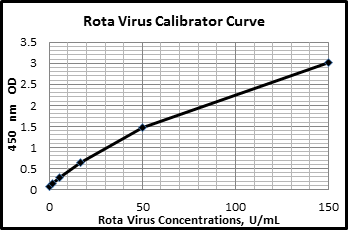Rotavirus Antigen ELISA Assay Kit
Rotavirus Antigen ELISA Assay Kit Developed and Manufactured in the USA
Size: 1×96 wells
Sensitivity: Cut-Off Control
Incubation Time: 2 hours
Sample Type: Stool
Sample Size: 90mg
For Research Use Only
Assay Background
Rotaviruses are the main and the most important pathogens that cause of non-bacterial acute gastroenteritis and diarrhea, especially in children from 6 months to 2 years of age, premature infants, the elderly, and the immunocompromised individuals. Rotaviruses have been identified in almost 40% of the feces of children with gastroenteritis. Rotavirus is the cause of up to 50% of the hospitalized cases of diarrhea in infant and young children. Almost every child has been infected with rotavirus by age 5. Over 3 million cases of rotavirus gastroenteritis occur annually in the US. There are about 120 million rotavirus infections every year worldwide and that causes the death of 600,000 to 650,000 children. Study also indicates that a high frequency of rotavirus infections may increase the risk of celiac disease autoimmunity in childhood in genetically predisposed individuals.
Rotaviruses have a genome consisting of 11 double-stranded RNA segments surrounded by a distinctive three-layered icosahedral protein capsid. The first layer is formed by the protein VP2, with each vertex having a copy of the proteins VP1 and VP3. The second layer is formed by the protein VP6. The outermost protein layer is composed of the structural glycoprotein VP7 and the spike protein VP4. Viral particles are up to 100 nm in diameter and have a buoyant density of 1.36 g/ml in CsCl. Rotaviruses tend to affect gastrointestinal epithelial cells that are at the tip of the villus. Their triple protein coats make them very resistant to the normally prohibitive pH of the stomach, and also digestive enzymes (lipases and proteases) in the gastrointestinal tract. During the infection, rotavirus produces mRNA to support both protein translation and genome replication.
Rotavirus is transmitted by oral-fecal contact with an incubation period of 1-3 days. Characteristic symptoms include vomiting, hydrodiarrhoea for between 3 and 8 days, high temperature and stomach pains. A large amount of rotavirus particles is shed during infection.
Specific diagnosis of the rotavirus infection is made by identification of the virus in the patient’s stool. Enzyme linked immunsorbent assay (ELISA) is the test most widely used to screen clinical specimens. Electron microscopy and polyacrylamide gel electrophoresis are used in some laboratories in addition or as an alternative to ELISA.
Products Related to Rotavirus Antigen ELISA Assay Kit
Giardia Iamblia Antigen ELISA Assay Kit
Cryptosporidium parvum Antigen ELISA Assay Kit
Adenovirus Antigen ELISA Assay Kit



